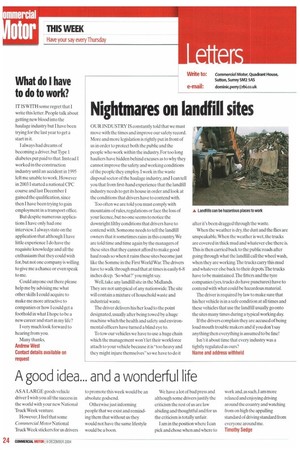Nightmares on landfill sites
Page 24

If you've noticed an error in this article please click here to report it so we can fix it.
OUR INDUSTRY IS constantly told that we must move with the times and improve our safety record. More and more legislation is rightly put in front of us in order to protect both the public and the people who work within the industry. For too long hauliers have hidden behind excuses as to why they cannot improve the safety and working conditions of the people they employ. I work in the waste disposal sector of the haulage industry, and! can tell you that from first-hand experience that the landfill industry needs to get its house in order and look at the conditions that drivers have to contend with.
Too often we are told you must comply with mountains of rules, regulations or face the loss of your licence, but no one seems to notice the downright filthy conditions that drivers have to contend with. Someone needs to tell the landfill owners that it sometimes rains in this country. We are told time and time again by the managers of these sites that they cannot afford to make good haul roads so when it rains these sites become just like the Somme in the First World War.The drivers have to walk through mud that at times is easily 6-8 inches deep. 'So what?' you might say.
Well, take any landfill site in the Midlands. They are not untypical of any nationwide.The site will contain a mixture of household waste and industrial waste.
The driver delivers his/her load to the point designated, usually after being towed by a huge machine which the health and safety and environmental officers have turned a blind eye to.
To tow our vehicles we have to use a huge chain which the management won't let their workforce attach to your vehicle because it is "too heavy and they might injure themselves" so we have to do it after it's been dragged through the waste.
When the weather is dry the dust and the flies are unspeakable. When the weather is wet, the trucks are covered in thick mud and whatever else there is. This is then carried back to the public roads after going through what the landfill call the wheel wash, when they are working.The trucks carry this mud and whatever else back to their depots.The trucks have to be rnaintained.The fitters and the tyre companies (yes, trucks do have punctures) have to contend with what could be hazardous material.
The driver is required by law to make sure that his/her vehicle is in a safe condition at all times and these vehicles that use the landfill usually go onto the sites many times during a typical working day.
If the drivers complain they are accused of being loud mouth trouble makers and if you don't say anything then everything is assumed to be fine!
Isn't it about time that every industry was a tightly regulated as ours?
Name and address withheld


























































































































































































